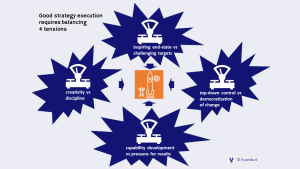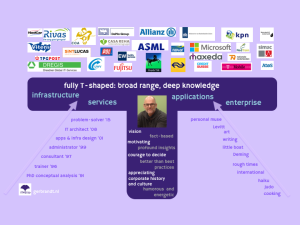Klanten veranderen het gebruik van je ontwerpen op een manier waarop je niet bent voorbereid. “I am very aware that I don’t know what’s going to happen. What I do know is that I need to be flexible and responsive” -Phil McKinney. En hoe anticipeer jij?
Auteur: gerbrandt van santen (Pagina 8 van 13)
A great design and now what? Without execution it’s a hobby and we are not in the hobby business. I have created a visual summary of Good Strategy Execution Requires Balancing 4 Tensions
Is it wrong to come up with results that are not perfect?
In my field of work, the IT architects seem to be the guys in an ivory tower preoccupied with the perfect solutions, never implemented. Do they take other people and reality seriously?
Old school versus executable architecture
The main difference between old school IT architecture and executable IT architecture is whether architects let themselves be influenced by the business: old school architecture is not influenced by the business. Let me explain that with a story.
Lovely carrot pastries
An organization has its own bakery to service the employees during lunch-break. The bakery sells carrot cake and carrot bread and carrot cookies. Is it a problem when these lovely products remain unsold? There is no problem for the baker: as a expert he appreciates the most wonderful, nutritious, CO2 neutral pastries he has created. It is a shame that nobody wants to buy these products, but the baker is happy about his products and will not be fired by his management: he is not depending on sales numbers. The management runs business, sees the need for healthy food and lacks the expertise and urge to decide on these food matters. It is annoying for the baker that he is requested by the other employees to advise on their lunch components: what would be healthy, nutritious, crispy, sweet or sour?
What would you do if you were the baker? Would you
- carry on with carrot products or
- will you complain about lacking management support or
- could you develop new products that are fun to make and fun to eat based on the wishes of your potential customers?
Carrying on with carrot products results eventually in a existence-issue: do we really need an own bakery selling products no one really wants to buy? That is not a viable option. And the second option? Well, I have been in an organization where management ordered everyone to buy the carrot products. Luckily our carrot products were of high quality. The customers were not delighted and were eager to find an escape route. But if you lack this support, how would you try to get that support of both management and employees? Do you need that support?
Void perfection
For most Enterprise Architects this is all a no-brainer: their work and products are important and of high quality. Sometimes they deliver not in time but that it because they have to do too many things for which they by principle should not be responsible, like advise or second-opinion or third level support on issues normal administration is uncertain about. Their role is like the Muppets Show’s character Sam the American Eagle: of highly moral standards completely out of order with their context. “The quality of my products is second to none” and everybody continues with business as usual.
First steps on a journey
For someone who wants to do executable architecture this context is the start of a journey, accompanied by questions like:
- Can I understand what my customers want and understand as healthy?
- Can I translate that in viable and usable products?
- Can I understand what my potential customers do not like about buying and consuming my products or services?
- Can I motivate my customers to change their minds on food habits?
- What would be the hookup to correlate with them?
- What are my and their constraints? In communication, producing and consuming?
These questions are related to the third option: not carrying on with “this is how we always have done it” nor requesting management support, but turning towards customers and have fun in creating products that will be sold. Still, too many architects are convinced they ask those questions already and have answered them consistently, by themselves. They have answered the questions without really listening to management and customers. Could it be that architects are highly intelligent and cooperative people that are themselves the roadblocks for progress? The conflict with their context becomes even greater when employees are absent because their unhealthy food habits and business -the object of management- is thus endangered: what is the point of an own bakery when it does not improve the average health? What went wrong, how can we improve this situation? Why can’t we have the baker put extra sugar in his products, perhaps that is not 100% healthy but always better than the present unhealthy food our employees consume?
You cannot answer the question whether or not architecturing is necessary and how to judge, use and evaluate archtecture by just creating another architecture as if that is a self-explanatory concept, clear to your readers and audience. The present history has shows that architecture is so untangible that continuing to do-your-thing is missing the point of the questions we, managers and customers are confronted with.
Executable architecture
Executable architecture aims at goals just like old school architecture but does so by solving present customers’ problems with solutions that aim at further rather general goals. The problems come first and out of the solutions we create directions, directives and goals are abstracted and defined. We should solve issues in such a way that we can leverage the solution in other cases as well. That is completely different from pondering in peace and come up with a principle a long time after the solution was needed.
In general it all depends on the acceptance of the imperfect, in work and private, and the improvement in small steps.
These thoughts are influenced by
- work on agility, architecture and provisioning of capabilties by Nanette Brown, and
- killer questions, by Phil McKinney, and
- wabi-sabi, the appreciation of the imperfect, like http://www.utne.com/mind-and-body/wabi-sabi.aspx http://seekeronline.info/journals/y2002/oct02.html
Image origins (unchanged usage):
If you really, really want to change and become happy, rich and a well-cited authority… well for most of us there are no shortcuts: it’s a rough and tough journey with obstacles.
Shortcut
But isn’t there somewhere a shortcut, a tiny backdoor? Why wouldn’t I be the one pulling the card from the pile saying “Advance to Go (and collect $200)”? Chances to win the lottery are smaller than dying of cancer, yet, we hope for the lottery and forget about our health issues.
Copy/Paste and Pimp
So, who needs another 10 skills to be happy? Well, I still want to be happy and rich and famous, so I give it a try, hoping for the lottery, the shortcut. Over the last months I have read my way through the advise coming from all over the world on being happy, a better colleague, famous, a good writer. By now I have a large collection of the required skill sets. These are my findings, perhaps you recognize them.
1. If all advice on LinkedIn is unique and should be added up, there are about 300 things to change in our lives. I simply have to stop working, since my natural blessings are so small that following all advice will be a complete working day burden. Since I pay rent and have children to feed, that is not a realistic option anymore.
2. If all advice is copied, revised and pimped with another picture of a happy child/girl/woman/young man/wise-looking elderly, is it then just for the matter of LinkedIn presence that we are confronted with yet another 99 skills to become whatever? A simple reference would do: take again a look at Guy Kawasaki’s insights or stop following Richard Branson and start reading Bill Gates.
3. No one tells me what my good fortune is when I score only 150 out of those 300: will I be semi-happy, drive no Tesla but at least a Mercedes?
Summaries won’t help
Now stop it, you may say, of course you are halfway to salvation. And true, not all 300 skills, perspectives, intrapersonal battles are unique, but they hint us in a certain direction. And no one says you have to follow all 300 hundred. Well then, please tell me which of the 300 are essential? Or would that be another set of 10 skills to funnel those 300?
It is your road with your stumbling stones
Let’s turn it around: no focus on a certain direction, skills or shortcut but look back at the road you’ve gone so far. Isn’t there any red line in your story amidst all the “non-you” things? A line that makes sense and let’s you make a new step in your life and profession? The journey is the reward and it would truly be your reward.
In my work as an architect it is exciting to find out my customers’ previous wanderings and to design the next steps on the roadmap, not as something completely new but built on the present story.
Does the past play a constructive role in your work?
Why should you struggle creating and reading lenghty resumes? Why not concentrate a resume in an infogram? Or a Powerpoint one-slider? Farid Mheir has given a beautiful example. I have taken up the challenge and this is the result.
Looking for more of these creative solutions for problems you have to solve?
I am available in January, 2016.
Waarom schrijven als het ook gesproken kan worden?
3 minuten video en toch alle informatie overgebracht:







